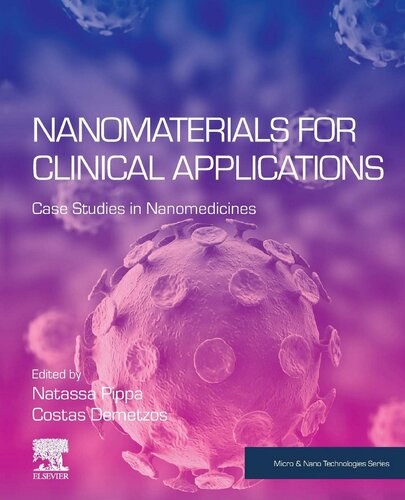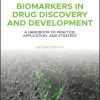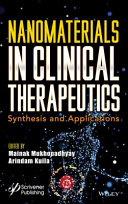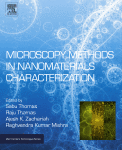Nanomaterials for Clinical Applications: Case Studies in Nanomedicines (Micro and Nano Technologies) 1st Edition Costas Demetzos 9780128168769 0128168765
$50.00 Original price was: $50.00.$25.00Current price is: $25.00.
Nanomaterials for Clinical Applications: Case Studies in Nanomedicines (Micro and Nano Technologies) 1st Edition Costas Demetzos – Ebook Instant Download/Delivery ISBN(s): 9780128167052,012816705X,9780128168769,0128168765
Product details:
- ISBN 10: 0128168765
- ISBN 13: 9780128168769
- Author: Costas Demetzos; Natassa Pippa
Nanomaterials in Clinical Medicine: Case Studies in Nanomedicines focuses on the nanomaterials that can be formulated as drug delivery vehicles, such as liposomes, micelles, nanoemulsions and nanogels. Their physicochemical, morphological, thermo-dynamical and nanotoxicological properties are analyzed with respect to the design and development of drug delivery nanosystems for the encapsulation of an active pharmaceutical ingredient and its controlled release. Each chapter covers basic properties, the nanosystem (e.g., liposomes), the added value in drug delivery and targeting, and future perspectives. Case studies and examples of how nanomaterials are being used in clinical medicine, including marketed liposomal medicines and medical utility and regimens are also included. Particular attention is given to new nanocarriers, such as elastic liposomes, lipid polymeric hybrid nanoparticles, organogel, nanofibers carbon nanomaterials, quantum dots and inorganic nanoparticles. This book is an important information source for those wanting to increase their understanding of what major nanomaterials are being used to create more effective drug delivery systems.
Table contents:
Chapter one. Solid lipid nanoparticles in dermaceuticals
1.1 General introduction
1.2 Why solid lipid nanoparticles?
1.3 Evolution of lipidic nanoparticles from solid lipid nanoparticles to nanostructured lipid carriers
1.4 Cosmetic and topical applications of solid lipid nanoparticles
1.5 Skin penetration with solid lipid nanoparticles
1.6 Mechanism of drug penetration with solid lipid nanoparticles
1.7 Incorporation into semisolid vehicle
1.8 Case studies of successful topical delivery with lipidic nanoparticles
1.9 Delivery of agents for other skin diseases
1.10 Conclusions
Chapter two. Cyclodextrin-based drug delivery systems
2.1 Cyclodextrins—structure, physiochemical properties, and toxicological profile
2.2 Cyclodextrin inclusion complexes—formation, stability, and application in drug delivery
2.3 Cyclodextrin-based products in clinical practice
Chapter three. Lipid vesicles for (trans)dermal administration
3.1 (Trans)dermal drug-delivery systems
3.2 Lipid vesicles for breaching the skin barrier
3.3 Liposomal formulation in clinics
3.4 Final remarks
Chapter four. Stimuli-responsive nanocarriers for drug delivery
4.1 Introduction
4.2 Types of stimuli
4.3 Development of chimeric stimuli-responsive liposomes with incorporated stimuli-responsive polymers
4.4 Thermotropic behavior of stimuli-responsive liposomes
4.5 Physicochemical properties of stimuli-responsive liposomes
4.6 Development of stimuli-responsive lyotropic liquid crystalline nanosystems
4.7 Conclusion and future directions
Chapter five. Biodegradable nanomaterials
5.1 Introduction
5.2 Natural polymers
5.3 Synthetic polymers
5.4 Polymeric nanoparticles
5.5 Clinical applications of biodegradable nanoparticles
5.6 Future perspectives
Chapter six. Modulating the immune response with liposomal delivery
6.1 Introduction
6.2 Liposomal immune modulation with small-molecule therapeutics
6.3 Liposomal immune modulation with liposomal gene vectors
6.4 Immune stimulation with liposomal vaccines
6.5 Conclusions and future directions
Chapter seven. Recent advances in solid lipid nanoparticles formulation and clinical applications
7.1 Lipid nanoparticles
7.2 Formulation components
7.3 Preformulation studies
7.4 Formulation procedures
7.5 Characterization techniques
7.6 Drug incorporation models
7.7 Administration routes
7.8 Solid lipid nanoparticles and nanostructured lipid carriers case studies in humans for medical applications
Chapter eight. Biopolymers, liposomes, and nanofibers as modified peroral drug release formulants
8.1 Introduction
8.2 Mathematical models for drug release
8.3 Release profiles comparison
8.4 Biopolymers in modified peroral drug delivery
8.5 Nanofibers in modified peroral drug delivery
8.6 Examples of liposomal-modified release formulations in clinical use
8.7 Conclusion
Chapter nine. Grafted polymethacrylate nanocarriers in drug delivery
9.1 Graft poly(meth)acrylates, including molecular brushes
9.2 Carriers based on poly(ethylene glycol) poly(meth)acrylate brushes
9.3 Carriers based on poly(ethylene glycol) grafted poly(meth)acrylates
9.4 Poly(ethylene glycol) and biodegradable polyester nonlinear amphiphilics
9.5 Other thermoresponsive graft polymethacrylate nanocarriers
9.6 Heterografted Janus-type carriers
9.7 Core–shell graft copolymers
9.8 Graft polymers containing disulfide linkers
9.9 Summary
People also search:
nanotechnology medical applications
application of nanotechnology in medicine
application of nanotechnology in materials science
application for nanotechnology
nanotechnology for biomedical applications
You may also like…
Engineering - Bioengineering
Nanomaterials in Clinical Therapeutics. Synthesis and Applications 1st Edition Mainak Mukhopadhyay
Uncategorized












